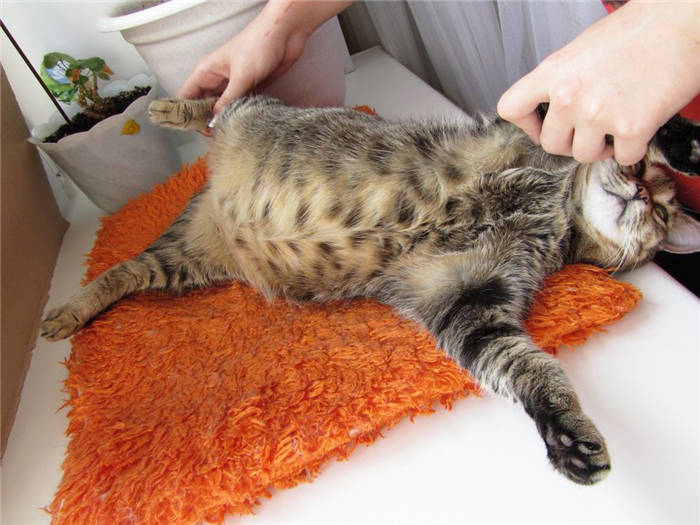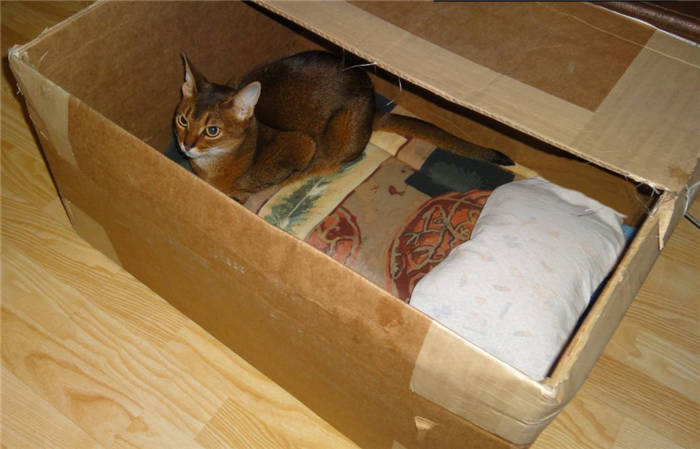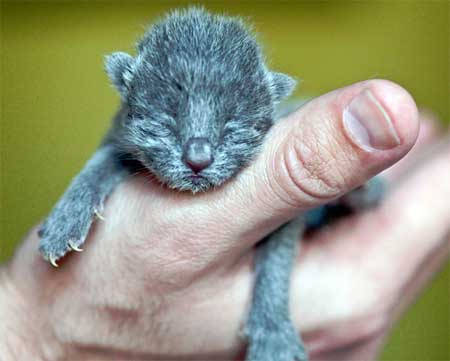With a normal pregnancy a cat gives birth easily enough and starts on time. In this case, no human intervention is necessary. However, the owner should be nearby and monitor the situation to help the pet if necessary, especially if it is its first offspring.
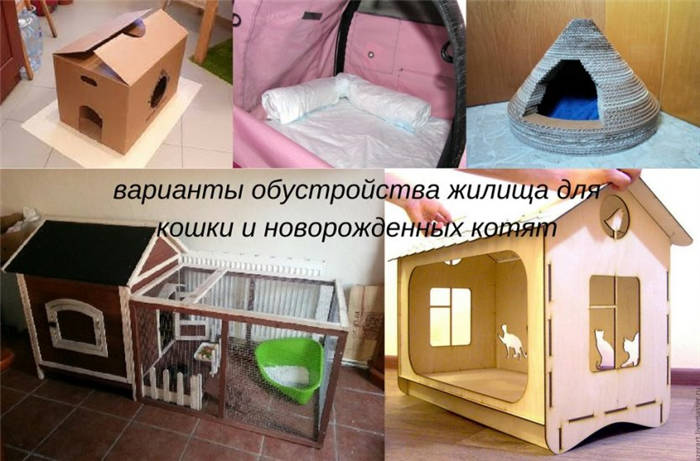
- Pregnancy and giving birth to a cat – what do you need to know, how to set up the nest and how to help 🙀🐱😺?
- How do you know if a cat is pregnant?
- I'm 12 years old, the cat is giving birth I'm alone at home what to do ?
- Caring for the mother cat
- Helping newborns
- What to do when a cat gives birth?
- Peculiarities of the first birth
- Help for complicated births
- Symptoms to watch out for
- Helping your pet when complications arise
- The birthing process – norms and abnormalities
- What should I do if there are complications during labor?
- How do I know when the birth is coming?
- What should be prepared for the cat and kittens?
- Therefore, here are the most important factors to know about the birth of a cat.
Pregnancy and giving birth to a cat – what do you need to know, how to set up the nest and how to help 🙀🐱😺?
Friends, last week you and I already started talking about a very important and serious topic – cat pregnancy.
This topic is serious because year after year, especially during the warm months, the same thing happens – a lot of unnecessary and, very often, doomed to death kittens are born in the yards of our cities.
And it is important to discuss this and make the simple point that animals need to be sterilized, there is nothing difficult about it.
Today we will discuss what to do if you suddenly or intentionally have a pregnant cat in your care.
There can be different options – either you intentionally brought your cat together with a cat, or you decided to help a street cat to give birth and later save and place its kittens, or you, again, took the cat from the street, and later it turned out that it was not alone and moved to you with future offspring 😊.
How do you know if a cat is pregnant?
Usually the first changes in the animal's behavior become noticeable as early as 2-3 weeks after the supposed mating:
- Increased sleepiness. Cats already like to sleep, but here the mother-to-be will also begin to refuse active games, will move more slowly than usual.
- Changes in behavior. Usually sociable cat may become suspicious and wary, and usually cautious and aloof cat may suddenly begin to demand more attention to himself, become more affectionate. Behavioral changes are affected by hormonal changes, after delivery the cat will return to its normal behavior.
- Changes in color and size of nipples. Nipples of pregnant cats swell and become bright pink (most often), the hair in the nipple area thinning.
- Weight gain. During pregnancy the average cat gains 1-2 kilograms.
- Change of appetite. In the first half of pregnancy the cat may start to eat less than usual, but from the second half of pregnancy it is vice versa. Food preferences may also change.
- Rounded belly. The main reason why we mention this obvious point – in no way try to feel how many kittens a cat might have! This you can harm not only the fetuses, but also the cat!
And to be sure you should call your vet and have an ultrasound done. After 14 days after the supposed mating it will be possible to determine if the cat has a fetal bladder.
I'm 12 years old, the cat is giving birth I'm alone at home what to do ?
If the cat is crammed into a corner or some hard-to-reach place, see if she was comfortable in the place you made, it may be worth changing the bedding. Once you are sure that the cat is comfortable and ready to give birth, prepare to help her yourself. Do not worry, because at this moment the cat needs a strong support, and she worries the most at this moment. She needs to feel that the owner is near and ready to support her, so that the cat will know that she is safe. As soon as you see undulating movements in the cat's belly, you can be sure – it's contractions. Cats before labor usually tense up, start meowing, shrieking, etc. On rare occasions, cats are remarkably quiet. Gently stroke the belly from top to bottom, so you make the process easier. If the cat is giving birth for the first time or the father of kittens was of large size, the birth may take longer, several hours. You should not worry at this moment, because the cat will feel the change in your mood, it will be transmitted to it. Remember: if you are worried, the cat will worry even more. The process is going on! After the contractions change, so called pushing, the first kitten will be born. After that the afterbirth will come out, if it won't come out by itself, pull the umbilical cord, but very gently, it usually helps. After that, your cat will bite the umbilical cord and start washing the kitten. Cats, in nature, eat this afterbirth, but at home it is not necessary, you can safely throw it away. In the first minute after the kitten is born, you can establish its sex, and you can do it as accurately as possible. In subsequent moments it will be difficult to establish it. After the first one is born, it's the second kitten's turn. And then all the others. You should always praise and pet the cat while it is giving birth, and speak softly and calmly, so that the cat understands that it is doing everything correctly. After delivery So, you know how to deliver your cat. In this, as you can see, there is nothing complicated, much less scary. The cat will "tell" you about the end of labor by itself, you will understand it by its behavior. But further there are a few more things to do. You should wash your hands and change the bedding with a new one, as the old one will be dirty. After that, the kittens will be ready for their first meal. Help them find the cat's nipple. When the kittens have drunk their mother's milk and begin to fall asleep, mom will want to eat and go to the bathroom herself. And you will need to make sure that all the kittens are born. Put the cat on her four paws and feel her belly with both hands, making sure there is nothing that looks dense or shaped like a kitten. Help from the vet If there are any abnormalities during delivery, call the vet immediately. These abnormalities include: 1) labor that began prematurely, up to 55 days, 2) prolonged pregnancy, more than 68 days, 3) prolonged labor (1-1 4) Kittens are coming into the world with a long interval of three to four hours; 5) During labor the cat excretes yellow and green fluid; 6) Kittens mucous membranes are covered with plaque and kittens appear sluggish; 7) Loss of uterus;  After delivery the cat has high temperature, refuses to eat, and there is a discharge from the vulva that gives very bad smell. But there is no need to worry. In most cases, the birth goes quite well. Now, knowing how to give birth, you will do it correctly and without problems. After the kittens are born, you need to confine the kittens and their mother from prying eyes, as this will cause anxiety and the mother will start hiding the babies, which may not end well.
After delivery the cat has high temperature, refuses to eat, and there is a discharge from the vulva that gives very bad smell. But there is no need to worry. In most cases, the birth goes quite well. Now, knowing how to give birth, you will do it correctly and without problems. After the kittens are born, you need to confine the kittens and their mother from prying eyes, as this will cause anxiety and the mother will start hiding the babies, which may not end well.
Caring for the mother cat
The act of giving birth is accompanied by a great loss of strength and energy in the animal. What to do when a cat has given birth to help it recover quickly? Immediately after giving birth, the new mother must be given water. Water should be freely available to the mother, close to the nest.
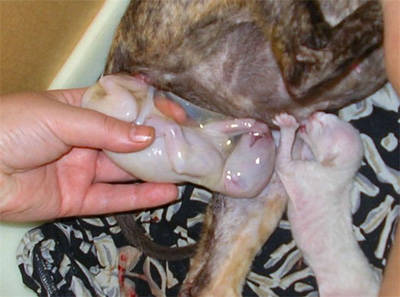
After delivery, the pet should be offered food. The ration should meet her energy needs, be nutritious and complete. The best option would be to feed a specialized food for lactating cats from well-known manufacturers of premium and super-premium class. These foods contain the perfect combination of nutrients, minerals and vitamins needed by the nursing mother and her newborn baby. The food should never be inside the nest. Both food and water should be placed near the box.
The litter box should also be close to the box with the kittens, so that the cat can go to the toilet without fear of leaving the cubs for a long time.
As for walks, especially outside, in the street, you will have to refrain from them for the time of feeding. Newborn kittens have weak immunity to viral, bacterial infections and parasites. And after a walk in the street, the animal is a dangerous source of infection for its babies.
After giving birth, for 7 to 10 days, the cat has genital tract discharge (lochia). During the first days they are smeary, reddish-brown in color. Then they lighten and become transparent. As a rule, females thoroughly lick the secretions and do not allow them to penetrate into the nest. But weakened and first-born females do not always cope with this problem themselves. In this case, the owner should help the animal – wipe the cat's genitals and thighs with a damp cloth or towel. To maintain hygiene in the nest, a disposable diaper should be changed daily. This is best done when the mother is out of the nest.
Helping newborns
After a cat has calved, what should be done with the kittens? Since they are born practically blind, the first thing to do is to take care that they are not irritated by bright light. To do this, the box is shaded with a cloth or placed in a dark place.
After a kitten is born, the mother chews the umbilical cord, eats the afterbirth and carefully licks the baby. For better healing, the umbilical cord can be treated with green or hydrogen peroxide. The owner should observe and make sure that the cat licks each cub. This manipulation is important for stimulating the sucking reflex, as well as for the normal functioning of the kidneys and the digestive tract. Newborns cannot empty their bowels and bladder on their own, they are helped by their mother.
The pet owner must supervise the feeding process. Make sure that all the babies are fed and have access to the teats.
It is not uncommon for kittens to be born weak and unviable. It is important to know what to do if a cat has given birth to premature kittens.
1) Artificial mouth breathing with a straw or small syringe can be used to stimulate the lungs, taking into account the volume of the kitten's lungs.
2) Rubbing, massaging the baby stimulates blood circulation and helps revive the weak cub. Manipulation should be done with a sterile tissue, massaging the body intensely, mimicking a cat licking.
3) A absorbent cotton soaked in ammonia helps revive a weak cub, stimulates an independent breathing act.
4) Create a temperature regime. Kittens should be placed under an infrared lamp or on an electric heating pad. In the first week the temperature should be kept between 29 and 32 C.
5) Providing additional nutrition besides mother's milk. Specialized kitten formulas are used for this purpose.
6) After consultation with a veterinary specialist, newborn babies can be supported with immunostimulant and vitamin preparations, glucose solutions.
What to do when a cat gives birth?
My cat is in labor right now, tell me what to do? ! My first kitten was born dead. She keeps purring and licking… She's curled up, too. Is that normal? Somebody tell me. >.< I'm home alone =_=
Maternal licking makes their lungs work. Then the cat bites the umbilical cord about 5 cm away from the kitten's belly to separate it from the afterbirth. If the cat does not do this, the owner should clean the kitten's eyes, nose and mouth of mucus and then carefully cut the umbilical cord with sterile scissors. You should not use new sharp scissors, because it is better to squeeze the cord first and then cut it. Then the kitten should be towel-dried and put in a warm place where you will put the others as well.
In these cases, sterile scissors, absorbent cotton and towels should be on hand. For feral cats, the placenta is food for a brief period until they can hunt after giving birth. Therefore, it is okay if a domestic cat eats the placenta and afterbirth. Cat labor is a fairly lengthy process, but you should keep an eye on it. Not all cats like to give birth in front of people, but some, on the contrary, need the presence of the owner. Cats rarely need help during labor, so it is best to leave them alone and not touch them in any way.
Whether you need to call a vet is still a question, especially if the labor began at night. What to do will tell you the state of the cat. If she purrs and actively licks the kittens, everything is normal. If she is suffering, you can tell right away by her behavior. If the pushing does not end with the birth of the kitten within 30 minutes, and the cat is twirling in place and cannot settle, that is a signal to consult a veterinarian by phone. Always be prepared to take your cat to the vet. Keep the kittens already born warm and consult with your vet whether or not to take them with you. In the warmth, kittens will survive until their first feeding. All of the above should not cause you to panic.
Peculiarities of the first birth
The first birth of a cat is an ordeal not only for the animal itself, but also for its owner. A first-born pet experiences a lot of psychological stress because everything that happens to her is unfamiliar and causes intense fear. The animal may show signs of aggression in the face of stress: hissing, not letting the owner near, biting and scratching. In fear, the cat may crawl under the sofa, bathtub and other places inaccessible to observation. The animal should not be allowed to do this, it must be calmed down and placed in a prepared box.
The first birth should always take place under the owner's supervision. A first-born animal may have weakened maternal instincts, in which case help is mandatory. If the cat gives birth for the first time, what to do and how to help the animal can be advised by a veterinary specialist, who will prescribe a mild sedative for the overly impressionable cat, if necessary.
Help for complicated births
If there are problems with kittens coming out of the birth canal, you need to know how to help the cat to give birth. You can give birth yourself in the following cases:
- A large kitten.. If the fetus does not come out because of its large size, you should lubricate the birth canal with sterile vaseline oil at a time when there are no contractions. The baby should be pulled by the fold on the neck, but only during the contraction along the arc to the cat's belly. The effort should not be excessive.
- Improper latching.. If the neck or back is visible in the birth canal, you should gently press the kitten, push it back and with stroking motions turn the baby's head toward the birth canal.
If you can see the lower back in the birth canal, the movements should be directed from the tail towards the neck: the kitten is turned to the breech.
If paws appear in the birth canal, you must wait for a period between contractions and push the fetus back, it will take the right position and the birth will proceed safely. All manipulation is done with sterile gloves, without effort.
To learn how to help a cat in a difficult labor, see this video:
- Weak or no labor activity. How to help a cat during labor if contractions are weak, infrequent and unproductive? In this situation, the owner can only help if the cervix is open (at least one kitten has already been born or the fetus has appeared in the birth canal). Massage of the cat's abdomen from the neck to the crotch with gentle circular movements without pressure, massage of the mammary glands will stimulate the birth. Strengthen the labor activity by putting the born cat's nipples to the nipples. Massage of the vaginal fornix will stimulate the continuation of labor activity. After prior consultation with a veterinarian, intramuscular injections of oxytocin are used to induce labor.
Symptoms to watch out for
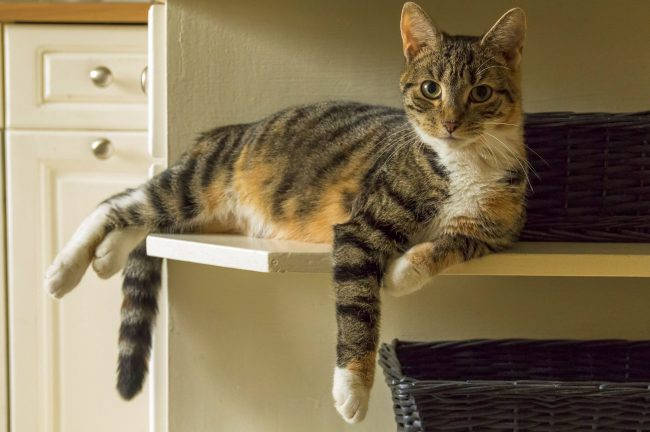
The cat owner who does not have veterinary training often does not know how to act when alarming symptoms appear. For this reason, you should get a veterinarian's phone number before giving birth, so that you can consult with him quickly and take action if necessary.
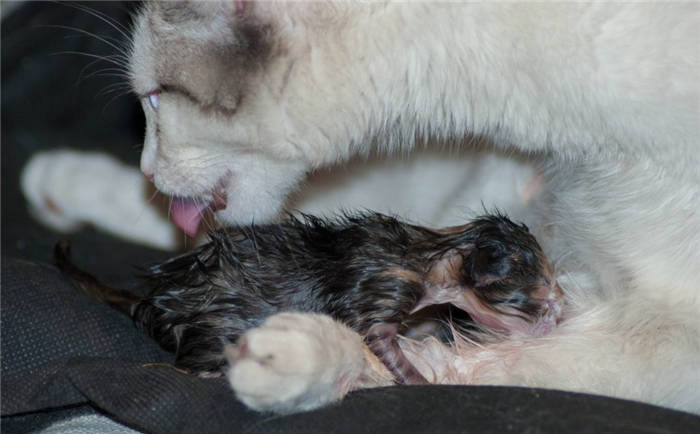
- The labor started too early. Early labor is usually caused by a frozen pregnancy, trauma, fetal abnormalities, and placental detachment. Labor proceeds quickly, and, as a rule, the cubs are born dead. Sometimes only one embryo is born prematurely, and the rest of the offspring are born on time. The causes of miscarriage can only be found out with the help of a specialist.
- Prematurity. When an animal does not go into labor, even on day 70, it may be an indication of a frozen pregnancy. The veterinarian can very likely assume that the kittens died intrauterine. In order to save the mother from intoxication and infection, it is necessary to operate urgently and extract them.
Read also: bleeding in a pregnant cat: what does a bloody discharge in an animal during pregnancy mean and what to do?
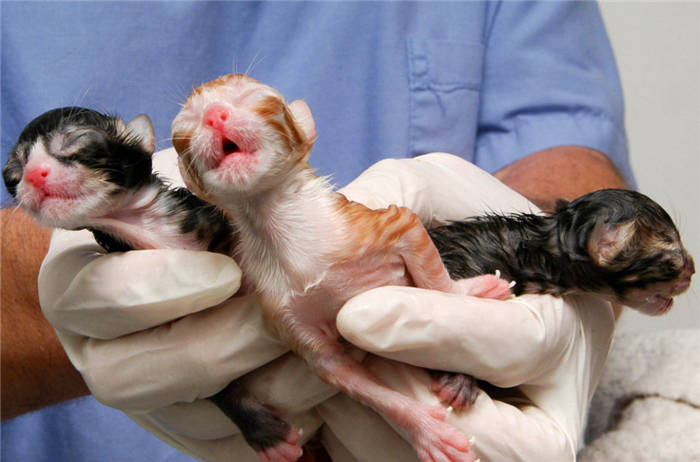
- Cessation of labor activity. During labor, the female may periodically rest. If at the same time she does not leave her seat, refuses to drink and takes care of the newborn without much interest, it means that the birth is not over yet. When 3-4 hours have passed since the birth of the last baby, and there is no pushing, you should palpate the cat's abdomen. High muscle tone indicates the presence of unborn kittens in the womb. In such a situation, you should consult a doctor or invite him home.
Helping your pet when complications arise
The greatest complications usually arise during the first birth. The responsibility for the cat and its cubs falls entirely on the owner, so it is necessary to prepare for this process in advance if there is no possibility of inviting an experienced veterinarian. To help in the event of complications, the cat owner will need the following medications and devices:
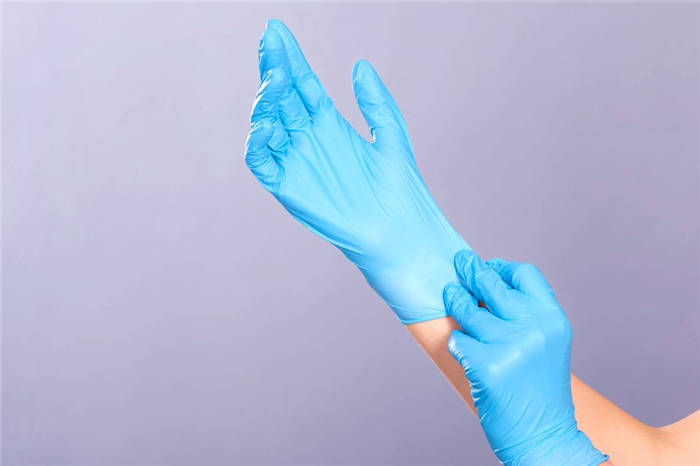
The above remedies should be used only in an emergency situation when labor is difficult. All possible complications and solutions are listed in the table below:
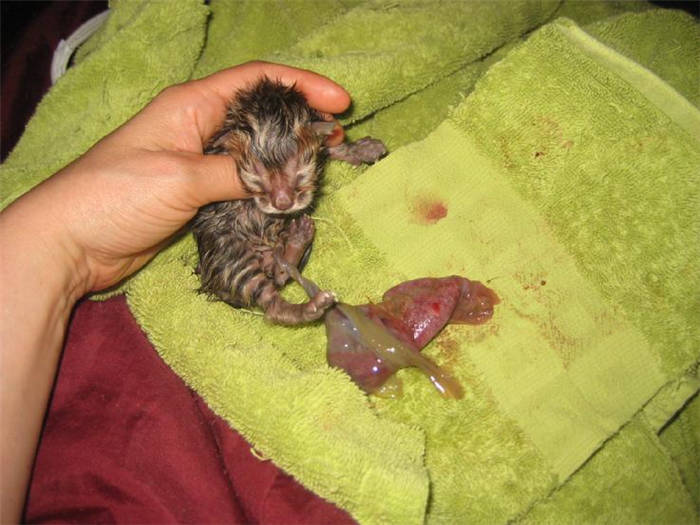
- weak labor activity;
- The fetus is stuck and is not advancing.
- soak a pipette in Levomekol ointment and insert it into the vulva, making circular movements;
- examine the birth canal to see how close the fetus is;
- give an injection of Travmatin or Gamavit in an amount of 1 ml into the withers;
- Stroke the laboring woman's abdomen from top to bottom.
- Weak pushing;
- stop exertion after the baby's head appears.
- treat the cat's genitals and birth canal with Vaseline, as well as the baby's head.
- give an injection of Gamavit into the thigh.
- refusal of the cat to chew the bladder within one minute after the birth of the cub;
- the mother is busy with another cub and does not have time to remove the bladder in time.
- cut the bubble tissue with sterile scissors;
- remove the newborn baby;
- remove mucus from the nose and mouth with a pipette or pear;
- wipe the baby with a towel and place it on the mother's stomach.
- lack of interest in the newborn;
- preoccupation with other kittens;
- lack of physical ability to chew the umbilical cord.
The birthing process – norms and abnormalities
Most cats are capable of giving birth on their own and without the owner's help. Do not interfere in the process if the cat behaves calmly and confidently.
Tip: Stay out of the way but in the cat's sight if the birth is going on without complications.
Forced interference in the birthing process, can increase your cat's stress and complicate the birthing process. Watch the cat's behavior, breathing and movements carefully. If the cat gets up and goes to the litter box while in labor, make sure that the fetal bladder does not appear in the birth canal when the cat defecates. If this happens, take the cat in your arms and move her nest.
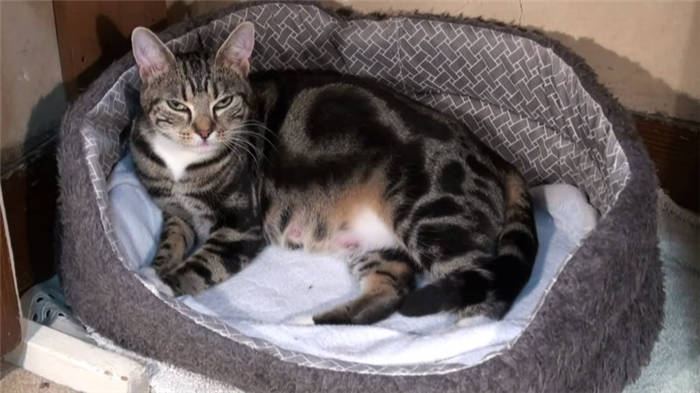
The first contractions are usually unnoticeable to the owner. In total, contractions can last up to 10-12 hours. The interval between weak contractions may be up to 30-40 minutes. Strong contractions can be seen visually, by the contraction of the abdomen and the cat's restless behavior. If a pet tries to hide, actively licks the genital area, breathes heavily and meows, it is likely that contractions will begin within 1-2 hours.
Note! 10-24 hours before labor, a cat's baseline body temperature may drop to 37-37.2 degrees.
You should have disposable gloves, a notebook and a pen at your disposal at the beginning of labor. Whether you like it or not, it is not possible to remain completely calm during the birth. Your job is to control your emotions as much as possible, to encourage and reassure your cat. As a rule, make a note of the birth of each kitten and the expulsion of the placenta. If there are more kittens than placentas after delivery, make sure you go to the vet, because ignoring the situation will lead to endometritis.
Make sure that the house is quiet during the cat's delivery. The cat in labor should not be disturbed by strangers, younger family members, your pets, or guests. The only exception is the presence of a veterinarian if the birth has complications.
What should I do if there are complications during labor?
In the above cases, it is difficult and dangerous to help yourself. Let's look at what complications you can help with.
The kitten is stuck in the birth canal. To facilitate the birth of the baby, the cat's genitals are generously lubricated with Vaseline oil using a syringe without a needle. During the next push, the kitten should be pulled up. If, in response to your efforts, the kitten does not slide down the birth canal, putting more effort is dangerous for the birth canal to rupture.
Improper fetal presentation. Kittens have a very high potential for survival. Stillborn babies need to be resuscitated! Clinical death up to 15 minutes immediately after birth is not thought to be dangerous to a newborn baby's brain. If the kitten is stillborn, it is intensively wiped with a dry towel, placed in warmth (on a heating pad, under a lamp), and a closed heart massage and artificial respiration is performed.
Closely monitor the cat's behavior. Artificial respiration before removing amniotic fluid risks lung rupture and death of the kitten. If the cat does not lick the baby, the amniotic fluid from the kitten's mouth and nose is removed with a syringe or baby syringe.
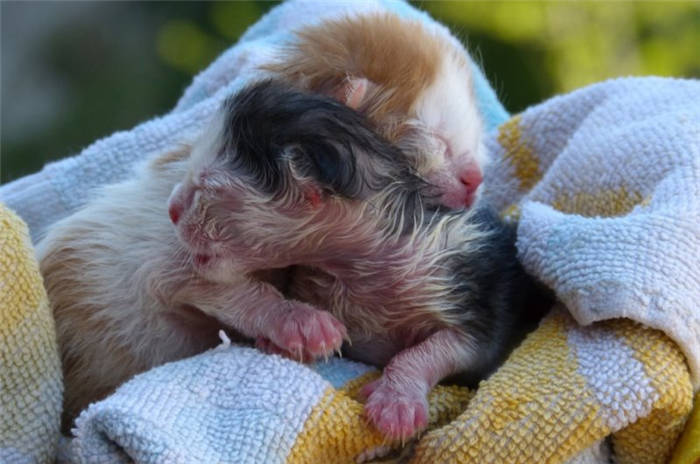
As soon as the kitten begins to breathe, you will hear a squeak. If the baby is clinically dead for too long, it may not move. Place the kitten on the heating pad and keep the cat occupied. After 10-15 minutes, rub the baby again and observe its movements. If the kitten began to actively move its paws, it should be placed under the mother's nipple.
Important! Temperamental cats are very concerned about their cleanliness during delivery. Quite often, after the birth of a kitten, instead of opening the bubble and licking the baby, the young mother begins to deal with her own hair. In this case, without wasting time, open the amniotic bladder near the kitten's muzzle, remove the fluid and start rubbing the baby.
How do I know when the birth is coming?
There are some signs that a cat is about to give birth to kittens. The cat's behavior changes: it becomes restless and walks from corner to corner, looking for a place to give birth. The cat's appetite decreases and it meows loudly. First-born animals do not always understand what is happening to them, so they may crouch under the sofa or bed. Pussycat labor precursors:
If your pregnant pet's mucus plug has come loose, it indicates that labor is starting. Noticing the plug, however, is not always possible, as its withdrawal is often partial. If the cat moves into a hunched position, it signals the onset of labour training. At this point the cat may call out to its owner, drawing attention to itself.
What should be prepared for the cat and kittens?
It is necessary to prepare a place for the cat to calve. It can be a paper box with low sides or a cot from which it will be convenient to get out. The cat will live with the kittens in this place for about 2 months, so it should be spacious. If a box is chosen as a temporary home, it is better to remove one wall to make it convenient for the pet to move around. This will also make it easier for the owner to access when the box needs to be cleaned. The calving area should be in a quiet, darkened area. The following items should be prepared before the cat begins to calve:
- latex gloves;
- cotton swabs;
- cotton cloth;
- scissors with rounded ends and alcohol to treat them;
- wet wipes;
- a thread soaked in boiling water (for tying the umbilical cord);
- terry towels;
- syringe or pipette;
- Liquid antiseptic;
- A syringe (to suction out the mouth and nose of newborn kittens);
- heating pad;
- Levomekol ointment.
Read also: Bleeding in a pregnant cat: what does bleeding in an animal during pregnancy mean and what to do?
You should take care to have a drinker with clean water for the cat. Kittens may need milk formula with a bottle, so it makes sense to buy it in advance in a pet store.
If it is known that the cat has to give birth within a week, you should put all the necessary items for giving birth in one place.
Therefore, here are the most important factors to know about the birth of a cat.
0. I give cats in the first month of pregnancy folic acid ¼ tablet once a day or 0.5 every other day. Calcium preparations – two weeks before delivery.
Folic acid – for the proper development of the fetus. In experience, it prevents the birth of kittens with a wolf's mouth, at least. Calcium – needed to prevent the cat from developing eclampsia after delivery.
2. After day 50, kittens can already survive if born at that time.
3. After day 50, you need to keep a better eye on the cat, try to make sure she bounces less and that she doesn't climb on top so she doesn't fall over.
4. The kittens begin to move at about day 50. Two weeks after that, the cat gives birth.
5. When the due date approaches, try to observe the cat. It is said that before the birth the kittens in the tummy will quiet down, pushing less. Before that, they push very hard, lining up in front of the birth canal.
6. Feel the cat's milk pouches. They fill up with milk before they give birth. If the milk has come, she will give birth today or tomorrow.
7. Cover the cat's space under cabinets under the bathtub or somewhere else where she can cram and where you can't get to her. It's the cat's instincts that push her to find a secluded place to give birth. But if you want to be able to help the cat if necessary, it's best not to let that happen. The cat can also hurt the kittens if she climbs in narrow passageways.
8. Prepare a box or tent for the cat, put it in a dark, quiet place, put a towel or blanket there – and let the cat choose what she likes.
9. Right before the birth, the cat's plug is a greenish-brown discharge from the loop. When the plug is out, the birth canal has opened, wait for delivery.
10. The first kitten usually takes longer for the cat to give birth. Be ready to support her, sit by her side, pet her. Hold the cat in the nest if necessary.

